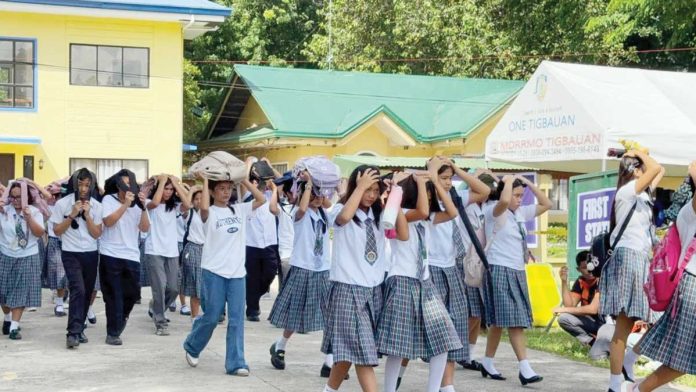
TIGBAUAN, Iloilo – Nearly 3,500 participants — including students, educators, first responders, and local officials — took part in a full-scale simulated magnitude 7.2 earthquake at Tigbauan National High School yesterday, June 19, as part of the second-quarter Nationwide Simultaneous Earthquake Drill (NSED).
Organized by the Office of Civil Defense (OCD) Region 6, the exercise aimed to test real-time evacuation, triage, rescue, fire suppression, crowd control, and command coordination protocols during peak school hours.
OCD-6 regional director Raul Fernandez emphasized the gravity of preparedness: “This exercise is not just a test. It’s a commitment to saving lives. By practicing our response, we strengthen our ability to act swiftly and efficiently when real disasters strike.”
Echoes of 1948 ‘Lady Caycay’ Quake
The simulated quake was not without historical precedent in the region. The most potent earthquake ever recorded on Panay Island occurred on January 25, 1948 — a magnitude 7.8 tremor dubbed the “Lady Caycay” earthquake.
Centered near Anini-y, Antique, its Mercalli intensity reached X (“Extreme”), ripping open fissures across Iloilo and Antique, and causing a small tsunami that reportedly killed two along the Iloilo Strait.
The destruction was widespread, and more evident on Spanish-era churches — 55 were hit and 17 collapsed outright. In Iloilo alone, belfries of historic churches in Jaro, San Joaquin, Arevalo and others toppled. Reports at that time told of approximately 21 fatalities and 43 injuries.
Infrastructure failure included large ground fissures (some up to four meters wide) and crumbling bridges and some buildings.
The “Lady Caycay” earthquake remains the second-largest in Philippine history, surpassed only by the 7.8 magnitude event near Luzon in 1990, and serves as a reminder: Panay Island is highly vulnerable to intense seismic activity due to the West Panay Fault.
The West Panay Fault is a significant geological fault line. It stretches over 90 kilometers, traversing towns in Iloilo (San Joaquin, Miag-ao, Igbaras, Tubungan, Leon, Alimodian, Janiuay, Lambunao), Antique (Sibalom, San Remigio, Valderrama, Pandan), Capiz (Tapaz, Jamindan), and Aklan (Libacao, Madalag, Malinao).
The fault has been linked to Lady Caycay earthquake and the 7.1 magnitude 1990 Panay earthquake, with its epicenter near Culasi, Antique.
The Drill
The June 19 exercise featured joint participation from:
* over 3,000 students, teachers, and staff of TNHS
* around 500 Municipal Disaster Risk Reduction and Management Council personnel; local government officials, Bureau of Fire Protection, Philippine National Police, Philippine Coast Guard, Municipal Social Welfare and Development Office, barangay units, and other emergency response teams.
Tigbauan’s School Emergency Response Team (SERT) and Incident Management Team (IMT) collaborated with the local Emergency Rescue Team, simulating realistic inter-agency dynamics. Observers from national and local disaster agencies witnessed the drill, which concluded with a critical after-action review.
Building a Culture of Resilience
The quarterly NSED, mandated by the National Disaster Risk Reduction and Management Council and OCD, aims to weave disaster resilience into the nation’s consciousness through regular, coordinated drills. By invoking the legacy of the Lady Caycay tremor, officials hope to sharpen institutional memory and public vigilance.
The Philippines is located within the Pacific Ring of Fire, making it highly susceptible to earthquakes and volcanic eruptions. This region, a horseshoe-shaped zone surrounding the Pacific Ocean, experiences frequent seismic and volcanic activity due to the collision of tectonic plates.
The Philippines, situated between the Philippine Sea and Eurasian plates, is particularly vulnerable to these hazards./PN






